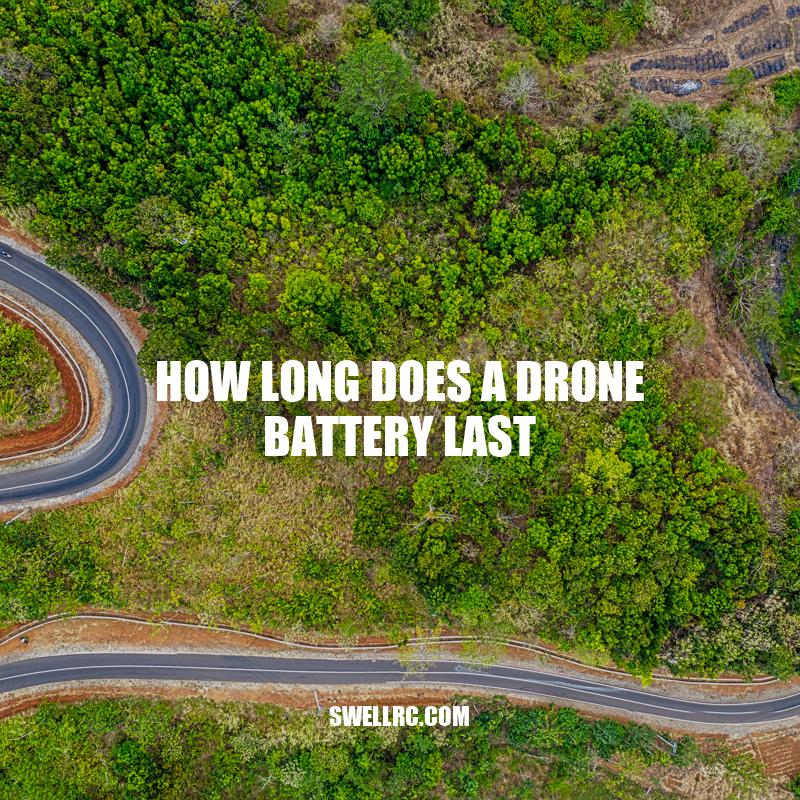Drone Battery Life: Your Complete Guide
Drone technology has evolved rapidly in recent years, expanding its usage in various sectors, from filmmaking and aerial photography to aerial surveillance, agriculture, and more. As drone usage becomes more widespread, battery life has become a crucial aspect of their effectiveness. Drone batteries power the motor, cameras, and other accessories that make drones valuable for a range of applications. Whether you are a professional drone pilot or an amateur enthusiast, understanding the battery life of drones is key to ensure that you get the optimal performance and don’t run out of power while flying. In this article, we will explore how long drone batteries last, factors that affect their lifespan, tips to extend battery life, and more to help you get the most out of your drones.
Factors affecting drone battery life
Several factors can impact a drone battery’s performance, including:
- Temperature: Battery performance drops in cold weather conditions, and overheating can cause battery damage and shorten battery life.
- Battery age: Like other electronic devices, drone batteries’ lifespan reduces as they age.
- Drone weight and features: Heavy and robust drones that carry additional equipment may drain their batteries faster.
- Flying conditions: Factors such as high winds, uneven terrain, and flying at high-speeds can drain your drone’s battery quicker.
- Advanced features: Features such as altitude hold, autonomous flight, and obstacle avoidance use more battery power.
It’s essential to understand these factors to be able to control or mitigate their impact on your drone battery performance. Some drone models include the battery life in their specifications. Check out drone reviews on websites such as Digital Trends or Techradar for more insights on specific drone models’ battery performances.
What Affects Drone Battery Life?
- The size and weight of the drone
- The capacity of the battery
- The flying conditions, such as wind or temperature extremes
- The level of usage, including speed, altitude, and camera or other accessory use
If you’re interested in improving your drone’s battery life, there are a few products available on the market that can help. For example, DJI offers high-capacity batteries, battery charging hubs, and other accessories that can help you get the most out of your drone flights. Additionally, drone enthusiasts can find various online resources and communities where they can share tips and tricks for optimizing their drone’s performance.
Types of drone batteries
Li-Polymer and Li-ion batteries power most drones. Here’s a quick comparison between the two battery types:
Li-Polymer batteries
|
|
Li-ion batteries
|
|
Despite their different features, both batteries can power drones quite effectively. It’s critical to choose the battery that suits your drone and flying needs. Research the specific requirements from your drone manufacturer’s website to see what is recommended for your drone.
Which is better lithium-ion or lithium polymer for drones?
When it comes to drone batteries, both lithium-ion (Li-ion) and lithium polymer (LiPo) have their pros and cons. Here are some key differences to consider:
- Li-ion batteries are generally more durable and have a longer lifespan than LiPo batteries.
- LiPo batteries are typically lighter and can provide more power output for their size.
- Li-ion batteries are often used in professional-grade drones because they can handle high current loads and provide consistent power over time.
- LiPo batteries are commonly used in consumer drones because they are more affordable and offer good power-to-weight ratio.
Ultimately, the choice between Li-ion and LiPo batteries depends on the specific needs of the drone and the intended use. It’s important to do your research and consult with the manufacturer or a trusted expert before making a purchase.
Average drone battery life
Different drones vary in battery life depending on multiple factors such as the drone’s weight, size, power consumption, and parts used.
Here are the average battery life of popular drone models:
DJI Mavic Air 2
- Max Flight Time: 34 minutes
- Battery Specs: 3500 mAh, 34.8Wh
Parrot Anafi
- Max Flight Time: 25 minutes
- Battery Specs: 2700 mAh, 20.4Wh
Autel Robotics EVO II
- Max Flight Time: 40 minutes
- Battery Specs: 7100 mAh, 82Wh
It’s worth noting that a drone’s average battery life can change depending on several factors such as the drone’s age, the type of batteries used, and the weather condition. As such, it’s crucial to understand these caveats to draw reliable conclusions about battery life. For further and more precise details about a specific drone’s average life, it is advisable to visit the manufacturer’s website or refer to their user manual.
Do all drones have short battery life?
Not all drones have short battery lives. The battery life of a drone varies depending on the model, features, and usage. Some drones have flight times of up to 30 minutes or more, while others may only have a flight time of 10-15 minutes. Higher-end models often have longer battery life and faster charging times.
If you are looking for a drone with longer battery life, research the different models available and read reviews to find one that fits your needs. Some websites that offer drone reviews and comparisons include:
- Drone Rush
- Tom’s Guide
- PCMag
- Digital Trends
There are also some drones that come with extra batteries or have the option to purchase additional batteries separately to extend flight times.
How long will drone batteries last and shelf life?
Drone batteries typically have a finite lifespan, and their longevity is dependent on several factors such as the quality of the battery, the type of the drone, and the usage. Most drone batteries are rated to last several dozen charge cycles before they need replacement. Here is some information to guide you:
Lithium Polymer versus Lithium-Ion
– Typically, Lithium Polymer (Li-Po) batteries last longer than Lithium-Ion (Li-Ion) batteries.
– A Li-Po battery will last about 300 charge cycles while Li-Ion batteries can last anywhere from 500 to 700 charge cycles.
Shelf Life
– Drone batteries have a limited shelf life, meaning that they cannot be stored indefinitely without losing capacity.
– Li-Po batteries have a shelf life of approximately 1-2 years while Li-Ion batteries have a shelf life of around 3-4 years.
It’s essential to keep in mind that the lifespan of drone batteries may vary depending on various factors, including the number of charging cycles, level of use, and storage conditions. To maintain the battery lifespan, avoid leaving the battery in a fully discharged state or overcharging/overheating it. Manufacturers’ websites or user manuals have recommended charging procedures and storage tips to help maximize battery life.
How long can the drone’s battery last?
– The average flight time of a drone battery is between 10-30 minutes.
– The flight time varies depending on the type and model of the drone, its weight, and the weather conditions.
– Some drones come with swappable batteries, which allows you to extend your flight time.
– It is important to read the instructions of your drone before flying it to ensure that you are maximizing the battery life.
– Some websites and product manufacturers have more information about their drone’s battery life and how to prolong it.
Tips to Extend Drone Battery Life
Here are some tips to help you extend your drone battery life:
Avoid flying in extreme temperatures
– High or low temperatures affect the chemical reactions that power the battery, leading to shorter flight times.
– Ideal temperature range is from 15°C to 35°C.
Fly in Ideal Weather Conditions
– Windy and rainy conditions will cause the drone to work harder, draining the battery faster.
Use the Right Battery Charger
– Always use the recommended chargers for your drone battery to avoid overcharging or undercharging.
– Avoid cheap, unbranded chargers that can damage your batteries.
Minimize the weight of the drone during flight
– The heavier your drone is, the harder it will have to work, draining the battery faster.
Use Efficient Flight Modes
– Lowering the drone speed or turning off certain features such as the LED lights can extend the battery life.
Carry extra batteries
– Sometimes, despite taking all the precautions and mindful flying, a drone may run out of battery.
– Always carry extra batteries that are fully charged to have a seamless flight experience.
By following the manufacturer’s recommendations, you can maximize your drone battery life and flight time. Consider purchasing batteries and chargers and other drone accessories from reputable websites and manufacturers’ stores.
How do I keep my drone battery healthy?
Here are some tips on how to keep your drone battery healthy:
- Do not let the battery drain completely.
- Store the battery at room temperature.
- Avoid exposing the battery to direct sunlight, extreme heat or cold.
- Charge the battery in a fireproof bag or container.
- Use the manufacturer’s recommended charger.
- Check the battery regularly for any damage or swelling, and replace if necessary.
For more information on drone batteries and drones in general, check out websites such as DroneJunkie and DJI. They provide helpful tips, product reviews and other useful resources.
Conclusion
Drone batteries are an essential component for drone operations. Understanding drone batteries’ life expectancy and best practices for maintenance and usage can help improve operational efficiency and enjoy longer, seamless flights. Proper maintenance of batteries, such as correct storage temperatures, avoiding overcharging or discharging and using the right charger, can extend its useful life. Always purchase from reputable manufacturers and sellers, and choose the appropriate battery size and type based on your drone model. While following the tips discussed, you can maximize your drone battery life and have enjoyable, safer flights. Keep in mind that flying a drone is fun when you know the lifespan of a drone battery and how it works. With proper care and troubleshooting, you can have countless hours of drone flying adventures that will give you cherished memories.



